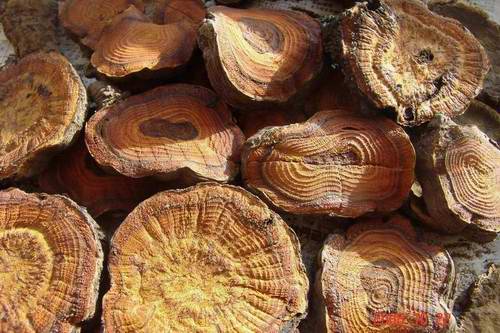Rhubarb collectively refers to a variety of perennials in the family Polygonum. It comes with a few different common names, such as Turkish rhubarb, Indian rhubarb, Chinese rhubarb, and Russian rhubarb. But in different contexts this herb has different definitions. In TCM it is known as the rhubarb root or Radix et Rhizoma Rhei in Latin, namely the dried root and rhizome of Rheum palmatum L., Rheum tanguticum Maxim. ex Balf., or Rheum officinale Baill. But in USA, Europe and the Middle East, it tends to mean a few edible species of the genus Rheum, mainly the R. rhabarbarum. There it is usually consumed as fruit instead of vegetable.
A perennial tall herb, in its natural habitat rhubarb plants usually grow in forest edge near the mountain or grassy slopes, wild or cultivated. It has stout rhizomes. Stems are erect, about 2m high, hollow, smooth, and hairless. Large basal leaves are with stout fleshy long handle, which is in similar length with the leaf. Inflorescence is large panicles, with terminal flowers. Pedicels are slender and with joints in the middle to lower part. Flowers are purplish red or mixed with red purple. Dark brown achene has 3 ridges, wings along the ridges, hollow top, and heart-shaped base. It blossoms from June to July and fruits from July to August.
Rheum palmatum has anthraquinone glycosides and dianthrone glycosides, which are the main cause why it is used as a laxative. Compared to its aglycone, these components have a stronger purgative effect. Anthraquinone glycosides include Chrysophanol-1-monoglucoside or Chrysophaein, Emodin-6-monoglucoside, Aloe-emodin-8-monoglucoside, Physcion monoglucoside, Rhein-8-monoglucoside. And Rheum palmatum L. alson contains Emodin diglucosi-de, Aloe-emodin diglucosi-de, and Chrysophanol diglucoside. Dianthrone glycosides include Sennoside A、B、C、D、E、F. Free anthraquinones include Chrysophanol, Emodin, Physcion, Aloe-emodin, Rhein, and so on. In addition, rhubarb also contains fatty acid, calcium oxalate, glucose, fructose and starch.
POPULAR RHUBARB ROOT RELATED HERBAL FORMULAS
On the basis of Traditional Chinese Medicine (TCM), rheum palmatum herb is viewed as bitter and cold in properties. It covers 5 meridians, including spleen, stomach, large intestine, liver, and pericardium. Its key functions are purgating heat and bowels, detox and cooling the blood, and restoring menstrual flow by expelling blood stasis. Its basic indications and uses are constipation due to excess heat, abdominal pain induced indigestion, dysentery and Diarrhea, damp-heat jaundice, spitting blood and nose bleeding due to blood heat, hot eyes, sore throat, abdominal pain due to Appendicitis, Carbuncle and boils, Amenorrhea caused by blood stasis, traumatic injury. Rhubarb root parched in wine is good at clearing blood aspect heat-toxicity in upper warmer and it is mainly used for red eyes, sore throat, and gingivitis; cooked rhubarb has relatively weak purgative effect and is used for skin and external diseases due to heat-toxicity; charred rhubarb works to cool blood heat, remove blood stasis and stop bleeding so that it is usually used for hemorrhagic fever accompanied with stasis. Usual dosage is from 3 to 30 grams, decocted later if used in purgation. In external use, apply appropriate amount of powder on the affected area.

Rheum Palmatum
1) Da Huang Fu Zi Tang
It comes also from Jin Gui Yao Lue. In this formula rhubarb combines with Fu Zi (Prepared Aconite Root) and Xi Xin (Chinese Wild Ginger) to cure acute appendicitis, acute intestinal obstruction, biliary colic, chronic dysentery, uremia and other diseases.
2) Da Huang Jiang Zhi Wan
This comes from Jiang Xi Zhong Yi Yao (Jiangxi Chinese Medicine). It is mainly used for hyperviscosity. Other key herbs include Hu Zhang (Bushy Knotweed Root), Zhi Shi (Immature Bitter Orange), Shan Zha (Hawthorn Fruit), Dan Shen (Salvia Root), and Dan Nan Xing (Jack in the Pulpit Rhizome and Bile).
3) Da Huang Mu Dan Tang
This formula comes from Jin Gui Yao Lue (Essential Prescriptions of the Golden Coffer). It is primarily designed for treatment of abdominal pain due to periappendicular abscess. Other major herbal ingredients are Mu Dan Pi (Tree Peony Root Cortex), Tao Ren (Peach Seed), and Mang Xiao (Mirabilite).
4) Da Huang Zhe Chong Wan
This prescription is also from Jin Gui Yao Lue. It is mainly formulated for stasis induced abdominal mass, amenorrhea, pelvic mass, endometriosis, secondary infertility, and more. Other major herbs include Tu Bie Chong (Wingless Cockroach), Shui Zhi (Leech), Meng Chong (Gadfly), Qi Cao (grub), Tao Ren, Huang Qin (Scutellaria), and so on.

![Diseases, Symptoms, tcm, [tcmwindow.com]](/uploadFile/adImg/2015/11/11/f5cbfcc0-4df5-4646-9b9a-f316651a0199.jpg)





